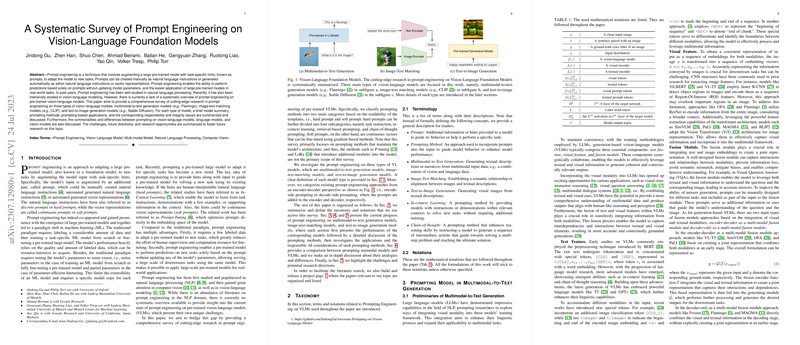Comprehensive Survey on Prompt Engineering in Vision-LLMs
Introduction to Prompt Engineering in Vision-LLMs
Prompt engineering has evolved as an innovative technique to adapt pre-trained vision-LLMs (VLMs) to new tasks without the necessity for extensive retraining or fine-tuning. This entails the augmentation of model inputs with task-specific hints, enabling models to understand and perform tasks with minimal labeled data. This paradigm shift has led to substantial efficiency gains, particularly in leveraging pre-trained models for domain-specific applications.
Taxonomy of Prompting Methods
Prompting methods in VLMs can be broadly classified into hard and soft prompts. Hard prompts consist of discrete, interpretable text tokens that guide the model, while soft prompts involve continuous vectors tuned to optimize performance on specific tasks. This classification offers a framework for understanding the diverse strategies employed in prompting VLMs, facilitating a structured analysis of existing methodologies.
Prompting Multimodal-to-Text Generation Models
Multimodal-to-text generation models synthesize textual descriptions from multimodal inputs. The integration of visual and linguistic information requires sophisticated prompting strategies to generate coherent and contextually relevant outputs. We explore preliminary models, prompt tuning strategies, and their applications in tasks such as visual question answering and image captioning. The role of both hard and soft prompts in enhancing model performance across these varied tasks is also examined.
Prompting Image-Text Matching Models
Image-text matching models aim to establish semantic relationships between images and text. We delve into different approaches to prompt these models, including patch-wise, annotation prompts, and unified prompting strategies that encompass both textual and visual information. The utility of prompting in improving task accuracy and model adaptability to novel scenarios is highlighted, with insights into future research directions.
Prompting Text-to-Image Generation Models
Text-to-image generation models represent a cutting-edge area where prompts direct the synthesis of images from textual descriptions. This section outlines the advances in prompt engineering for such models, emphasizing complex control over the generation process through semantic prompt design, diversified generation, and controllable synthesis. The expansion of prompting techniques to generate videos, 3D models, and perform complex tasks further underscores the potential of prompt engineering in creative and practical applications.
Challenges and Future Directions
The survey identifies several challenges in the current landscape of prompt engineering for VLMs, including the need for better understanding the mechanisms behind in-context learning and instruction tuning, and exploring efficient strategies for visual prompting. The potential for universal prompts and ethical considerations in prompting VLMs also present areas for future exploration.
Conclusion
Prompt engineering has revolutionized the application of pre-trained VLMs, enabling task-specific adaptations with unprecedented efficiency. By systematically categorizing prompting methods and examining their applications across different model types, this survey provides a foundational understanding and highlights the potential for innovation in prompt engineering within vision-language research. As the field continues to evolve, focusing on novel prompting strategies, ethical AI considerations, and cross-model applicability will be crucial in realizing the full potential of vision-LLMs.
